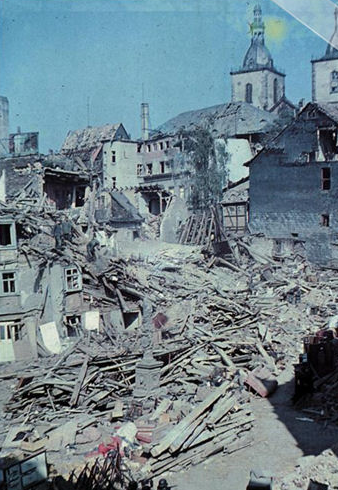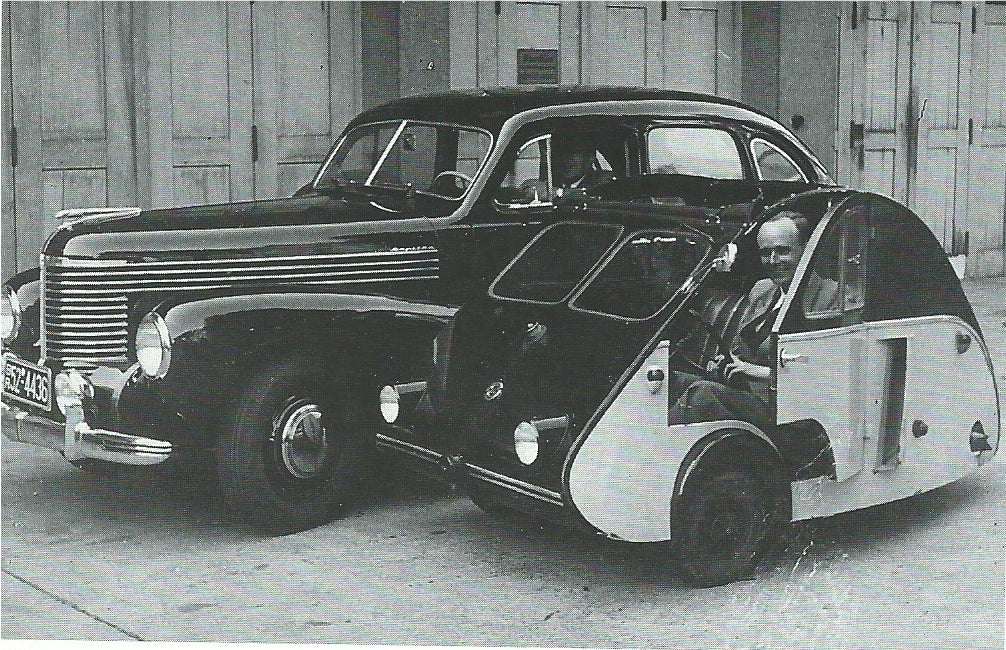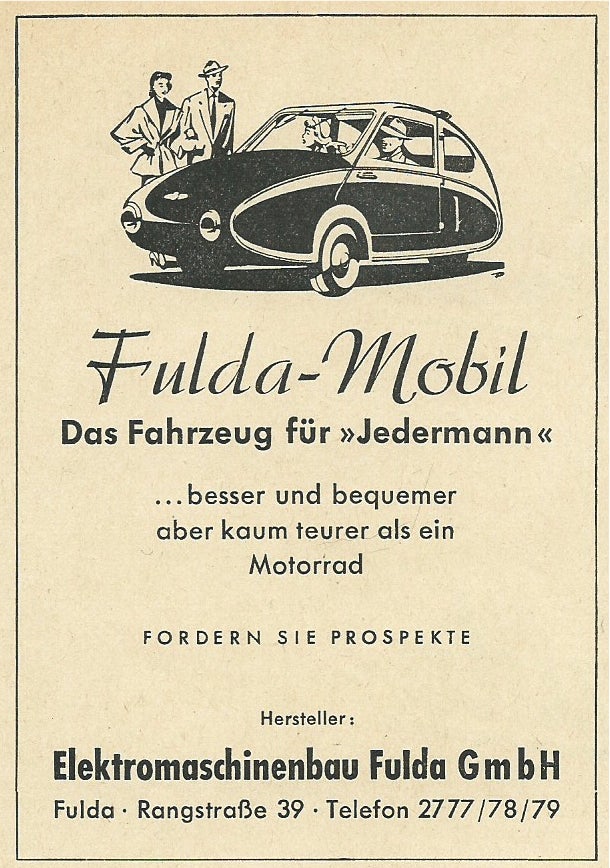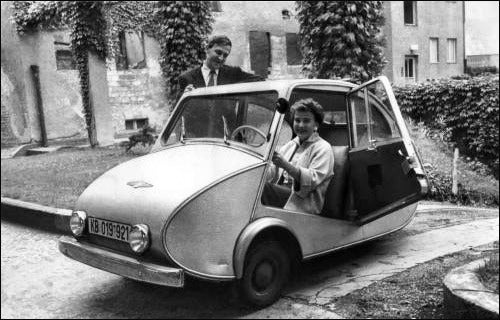 "Jonee" (Jonee)
"Jonee" (Jonee)
11/25/2014 at 10:59 • Filed to: Fuldamobil, Microcars, Automobile History
 7
7
 3
3
 "Jonee" (Jonee)
"Jonee" (Jonee)
11/25/2014 at 10:59 • Filed to: Fuldamobil, Microcars, Automobile History |  7 7
|  3 3 |

Note: This one is pretty long, so I've broken it into two parts. I figured some of you might want something interesting to read when you're bored over the holiday weekend. If not, there's a bunch of neat pictures.
Everyone's got a favorite car and this is mine, the Fuldamobil N-2. I first saw one while flipping though an old automobile encyclopedia and I couldn't stop staring at it. It looked like it was designed by someone who had never seen a car before, but maybe had one vaguely described to them. "It's got doors, windows, wheels, and people sit in it. What more do you need to know?" It looks funny at first, but the more you stare, the more its minimal utilitarian charm gets to you. It's maybe the car version of a quonset hut. Sometimes you love a car because of how it performs and sometimes you love a car despite how it performs. This is one of the latter times. An old German once told me they were thought of as "old lady cars." Old ladies had pretty rad taste back then, I guess. It's powered by a defective chainsaw engine and it's rather uncomfortable to drive, but it does feature a novel piece of automotive engineering that's probably on the car you drove today. The saga of Fuldamobil is a convoluted tale that begins on the eastern front during WWII and continues on to this day.

Norbert Stevenson was a reluctant 25 year old soldier freezing with the German army outside Stalingrad in the winter of 1942. Stevenson was an obsessive dreamer who would distract himself from the boredom, hunger and cold by imagining his life after the war. It was typical fantasy; a beautiful wife, large family, and, most importantly, an achievement that left a mark on the world. Norbert wasn't sure what that would be, but he felt if he could survive the fighting, he'd make sure he did something important and beneficial to make all this suffering worth it. The Nazis lost somewhere around half a million men at Stalingrad. Fortunately for Norbert, he only had to sacrifice 3 toes before he managed to get himself recalled to Berlin at the end of the year. To avoid returning to the front, he enrolled at the Technical Institute of Berlin to study engineering. After one semester, he was discharged from the army and went to work at a paper factory that was considered vital to the war effort. This job kept him from getting re-conscripted when things got desperate. Norbert obviously held no ill will towards Russians since he fell in love and married one. Valentina was young and pretty and had avoided the labor camps because she spoke fluent German. She worked at the paper mill as an interpreter where she met Norbert who saw the girl he had daydreamed about back at the front.

They were wedded after Germany's surrender in the bombed out cathedral in the small medieval city of Fulda where the Stevenson family home had luckily missed being destroyed , and where Norbert's cousin, Karl Schmitt owned a Bosch factory, the Elektromaschinenbau Fulda GmbH.

Schmitt was a cunning industrialist who made his factory vital by stocking up on emergency generator parts to make his own generators, and then undercutting other Bosch plants. Fulda generators became the Wehrmacht's choice and Schmitt also avoided being drafted into the army. After the war, he kept on producing generators for the occupying Allied forces. With his plant one of the few still standing, he had the market cornered and business was good.
In 1947 Norbert was working as a freelance journalist for a small newspaper. Writing was something he had fallen into and was not what he saw himself being successful at. Before the war, in the few months between graduating high school and entering the Reich Labor Service, Norbert had apprenticed at the Stoewer automobile factory. Stoewer made luxury sports cars that competed with Horch and Mercedes, but also a small, efficient, well-built economy car. Norbert had always been a car enthusiast and in postwar Germany all he saw were American military vehicles and prewar German beaters running on wood gas.

And those were driven by the lucky few who still had a car. Most people were on scooters or motorcycles. Norbert recognized a chance to realize his ambition to accomplish something of importance. He would design the perfect people's car. At the time, Beetles were being produced in small numbers and, believe it or not, were considered a middle-class car. They seated 4, made 30mpg, and cost almost 5500 Marks. Based on a poll conducted by his paper, Norbert realized people needed something that was half as expensive, got 40mpg, and 2 seats were plenty. So, he began to spend late nights in his basement experimenting with wood, cardboard and whatever else was laying around to come up with a design for a new kind of car. A microcar that the poorest citizen could afford. After several months he had cobbled together a chassis for a three-wheeler and stuck an old Horex motorcycle engine in it. But, the writing wasn't going well and he was so broke he had to sell off the parts. So, not long after, he started from scratch and, many days and sleepless nights later, he had a new design and mock-up that he felt was ready enough to show to an investor. And, the first person he thought of was his cousin Karl who was sitting pretty with emergency generator profits.
Armed with his poll data, scribbled plans, and a full sized wood and cardboard model, Norbert invited Karl into his work dungeon in early 1949. The place was cramped and Norbert had to move a pile of boxes to reveal his creation, but he beamed with pride. It again had three wheels with one in front and tandem seating like a motorcycle. It was pretty much a box with a couple of seats in it and looked like someone with 3 months working in a car factory and 1 semester of engineering school had designed it. Schmitt hated it. He knew a single front wheel was unstable and the passenger sitting behind the driver was just dumb. But, he saw potential in the idea of ultra cheap transportation and Norbert was beyond enthusiastic. There was room at his factory for a small production facility, so, he figured what the hell. The only catch was that Valentina was pregnant and Norbert needed a steady paycheck. Since he was family, Karl agreed to put him on the payroll so he could work on the car full-time. So, Fuldamobil was born.
Norbert started over on a new design once again. This time, he moved the passenger next to the driver which meant a wider vehicle. Since he wanted to keep to 3 wheels to keep costs down, Norbert started thinking of ways to ensure the car was stable especially on Germany's rough, postwar roads. One issue he wanted to solve was keeping the car straight when it hit a pothole, or when braking is uneven between the two front wheels. One thing he figured would work was if the steering geometry had a negative scrub radius. !!!error: Indecipherable SUB-paragraph formatting!!! is the distance on the turning radius the tire has to scrub along the ground when steered. You can figure it out by drawing an imaginary line through the upper and lower ball joints and seeing where that line meets the center line of the tire. If they intersect at the road surface, you have a neutral scrub radius; below the road, positive; and above the road, negative. ( !!!error: Indecipherable SUB-paragraph formatting!!! helps visualize it.)
No car before had ever had a front suspension setup with negative scrub radius because I guess no one had thought of it, plus it was difficult to achieve especially in the days before MacPherson struts. Norbert managed it by pushing the suspension joints into the wheel rim. This allowed the the steering axis and the swivel pin to lie exactly on the longitudinal axis of the wheel for a real "center point axle." It would be complicated and expensive, but it worked, even if I don't entirely understand it.

6 years later, the Citroen DS would have something similar, but that car was designed by aliens. Not until the Audi 80 in 1972 would a car have a true negative scrub radius. Today, almost all front wheel drive cars have a steering geometry based on Norbert Stevenson's principles. So, the next time your car hits a pothole and doesn't veer off the road, you can thank the tiny Fuldamobil.
Schmitt thought the complex setup was too costly and intricate for a car that was supposed to be the cheapest of the cheap, but Norbert insisted it would make the car ride better and much safer, so Schmitt relented.

By December of 1949, Norbert had built his fancy front suspension and had a chassis made of tubular steel. It took some black market trading to get parts, but it was true to his vision. It was rather heavy for its size at 313 lbs, but strength and stability was important.

He mounted a Zundapp 200cc motor to it and took it for a test drive on Christmas day. He was joined by his assistant, Werner Zissner, and Karl Schmitt watched on as snow fell. Norbert's design worked perfectly around the beaten factory parking lot and he was delighted. Without a body, the little Zundapp two-stroke was able to get them going pretty quick, and it handled incredibly well for a trike. When it came time to stop, one compromise made to fit the negative scrub radius setup became glaringly obvious. To make room, very small cable brakes meant for a scooter were used and they were barely able to stop the heavy chassis and two men. Apparently, Herr Schmitt nearly had his legs broken by the out of control prototype. Still, the test was a resounding success and with a little work, they would be ready to build a complete car. Stevenson and Zissner spent the winter driving the chassis around Fulda's city center and past the cathedral Norbert was married in. The townsfolk would come out to watch and apparently everyone was pretty psyched about the idea of a car factory in town. It meant more jobs and also gave people hope that things might be getting better.
While Norbert got the chassis and brakes dialed in, Karl Schmitt went in search of a coach builder. Resources were pretty scarce, so he and Norbert had planned on the car being built from wood, which was still cheap in Germany. Right in Fulda was a company called Leibold that made hand built wooden campers. They were perfect for the job and they're the main reason the car looks like a motorized teardrop trailer. In just 8 days, they constructed a beautiful wooden frame with plywood body panels.


Over the plywood they hammered on aluminum sheets and painted it black and white. It's absolutely adorable and basically pocket-sized. Zissner said it was like driving around in an antique wardrobe. It was so sturdily built that it weighed more than the chassis which became a bit of an issue. The tiny car made it's debut at Fulda's first postwar Rose Monday parade in February 1950. It created quite a buzz until it petered out on a hill just outside the town center. The heavy wood body was too much for the little Zündapp which wasn't equipped with a cooling fan. Despite having to push it home, the local press proudly announced that the new Fuldamobil was technological marvel.
Besides the engine failure, the car was said to have rocked like a ship on the ocean due to having transverse leaf springs, but no shock absorbers. Norbert added front and rear shocks and coil springs and set about making other refinements while Schmitt went in search of a new power plant. His first visit was to Triumph in Nuremberg who had a new dual-piston 11 horsepower scooter engine that would have been perfect. Unfortunately, the company director took one look at the prototype Fuldamobil and laughed saying it looked like a "weird cello case." Insulted, Schmitt left in a huff. He ended up making a deal with Baker & Pölling to purchase 100 two-stroke chainsaw engines. B&P promised to up its displacement from 200 to 250cc which would give it a barely enough 8.5 horsepower. It was made of lightweight aluminum with lined cylinders and the price was also half the Triumph's. Hurth in Munich supplied a 3-speed transmission with reverse that was meant for Asian rickshaws. Norbert gave it a reliable chain drive. He designed a roomier body that was also to be produced by Liebold which extended the car's wheelbase from 1,000 to 1,500mm.

Production was underway by Christmas, 1950. To keep the price at 2250 Marks, the aluminum skin was eschewed for either just paint, or for a little extra, fabric backed vinyl similar to the first Lloyds. Interestingly, though, the first Fuldamobil sold was an experimental steel-bodied roadster.

The metal body was too expensive for production plus it was even heavier than the wood cello case. Norbert wanted it scrapped because it didn't perform well, but if someone was willing to pay for it, Karl wanted the cash. In the first six months, Fuldamobil sold 48 of the wooden bodied cars in sedan and droptop form.

It was a good start for a bunch of guys who didn't really know what they were doing. The cars were cheap and well made, but the attention to detail in the hand built machines meant profits were low. The wood frame was complicated and the chassis was put together with long welds that took 10 hours on their own. As the cars began to rack up kilometers in the real world, it became clear the Baker & Pölling motor was poorly manufactured shit. The piston pinged against the cylinder head sometimes shooting out of the horizontally mounted block into the back of the bench seat. Some drivers thought they'd been shot. Schmitt was furious and demanded the maker repair the motors. B&P did a shoddy job installing some useless rubber dampeners. When a second order of 100 engines was delivered, Schmitt refused to pay for them until the first batch proved reliable. Before that happened, Baker & Pölling went under and Fuldamobil had itself 100 free, albeit possibly defective, motors. Some seals made them usable, but lessened compression and thus sucked the already weak motor of power. Also, the car's wedge shape proved problematic as the windshield was too raked to be properly defrosted either by the weak and no longer warm blower, or hand.
So, Stevenson tweaked the design, raising the prow and making the windscreen more upright. This had the effect, at least to German factory workers, of making the front of the car look like a pair of breasts. I assume they mean under a sweater like Jayne Mansfield unless their ideas of anatomy are a little screwy. Anyway, they started calling it the "breast car." Hilarious.

Karl Schmitt made a deal with Fitchel & Sachs for their proven 360cc 9.5 horsepower motor which was bulletproof, but a stationary engine not meant for a car. Its larger displacement also meant class IV drivers could no longer drive the car, which limited potential buyers. It cost more than the old Baker & Pöllings which upped the price of the car to 2450DM, but it didn't launch its piston like a rocket. For the new body, Schmitt and Stevenson decided to find a new builder who could make it lighter. They found a company called Schliecher that made gliders who managed to cut the body's weight almost in half. This was proven when one of the first to be delivered flew off the truck on a gust of wind only to come to a gentle rest in a meadow. A new and unique unpainted hammered aluminum skin was now attached to the body panels.


It's got a real steampunk quality and is the only car I've ever seen with a permanent case of hives. The shiny little "Type N" got the nickname the "silver flea."

320 "N's" were sold between August '51 and September '52. Less than 1 a day was pretty slow even with the Fulda being one of the few microcars available. Its main rival was the even tinier open-bodied Kleinschnittger. But, the few who did buy Fuldamobils loved their cars and drove them with pride.

Letters from loyal customers to the factory describe trips all over Europe in the little things. One woman got her driver's license, bought a Fuldamobil the next day and within a week had left for Madrid. The car made the trip with no fuss and once there was gawked at by astounded Spaniards. I don't know if they were impressed with the car or the fact that she survived the journey. Back then, buying a car, even a humble Fuldamobil, was such a big expense, that you would never then splurge on train or, God forbid, plane tickets. That car was how you got to where you needed to go whether it be down the street for groceries, or a vacation to Spain. Fuldas were taken over the Alps and around the Mediterranean. That one lady's car wouldn't be the last Fulda to make the trek from Germany to Madrid. And it really must have made an impression because 4 months into production, a Spanish company contacted Karl Schmitt about obtaining a license to build Fuldamobils. To prove the car's worthiness and durability, Schmitt organized a caravan of six of the tiny caravans that drove to the Spanish capital arriving on New Year's Eve.

They made the trip over the snowy Pyrenees better than the Volkswagen transporter that accompanied them. Unfortunately, the deal fell through, but the idea of licensing Fuldamobils would stick in Karl Schmitt's mind as a way to boost profits.
A few Fuldas also rallied in the motorcycle with sidecar class. They were slower than the bikes, but performed well in rough and muddy terrain earning a special medal at a four day ADAC race.

By 1953 production was up to 8 cars a week and Fuldamobils had garnered a loyal following. The press was not effusive with praise, the brakes were still not great and the center point axle caused there to be a hump right under where your feet go when you're driving, but they still noted the car's build quality and good handling.
Even though cars were being produced faster, they weren't really selling at a greater clip, so Karl decided to look for a way to bring production costs down.
!!!error: Indecipherable SUB-paragraph formatting!!! IS !!!error: Indecipherable SUB-paragraph formatting!!!
!!! UNKNOWN CONTENT TYPE !!!

 505Turbeaux
> Jonee
505Turbeaux
> Jonee
11/25/2014 at 11:05 |
|
If I ever start a microcar museum you will be the curator sir
 Jonee
> 505Turbeaux
Jonee
> 505Turbeaux
11/25/2014 at 11:08 |
|
Thanks. Needless to say, that would be my dream job. So, get on it.
 505Turbeaux
> Jonee
505Turbeaux
> Jonee
11/25/2014 at 11:11 |
|
haha I wish too.
/busy playing lottery